fold seats AUDI Q7 2012 Owner´s Manual
[x] Cancel search | Manufacturer: AUDI, Model Year: 2012, Model line: Q7, Model: AUDI Q7 2012Pages: 342, PDF Size: 86.42 MB
Page 77 of 342
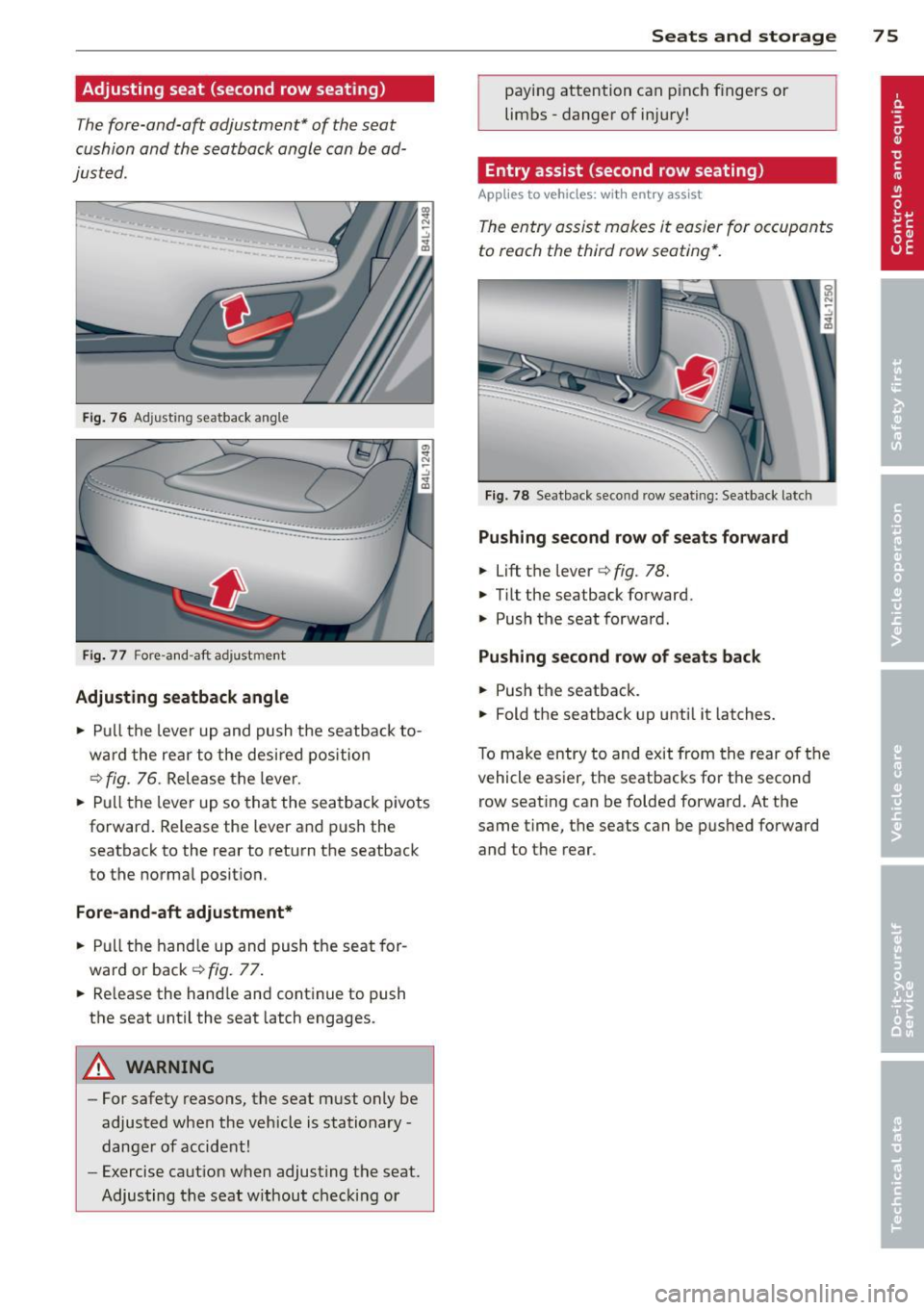
Adjusting seat (second row seating)
The fore-and-aft adjustment* of the seat
cushion and the seatback angle can be ad
justed .
Fig. 76 Adjust ing seatbac k an gl e
Fi g. 77 Fore -a nd -aft ad just ment
Adjusting seatback angle
,. Pull the leve r up and push the seatback to
ward the rear to the desi red pos ition
¢
fig. 76. Release the lever.
... Pull t he leve r up so tha t the sea tback p ivots
forward . Release the lever and p ush the
seatback to the rear to return the seatback
to the norma l posit ion.
Fore-and -aft adjustment*
... Pull the hand le up and push the seat for
war d or back ¢
fig. 77 .
... Re lease the hand le and continue to push
t h e seat until the seat latch engages .
A WARNING
-For safety reasons, th e seat must only be
adjusted when the vehicle is stationary -
dange r of accident!
- Exercise caut ion when adjusting the seat.
Adjusting t he sea t w ithout chec kin g or
Seats and storage 75
paying attention can p inch fingers or
limbs - danger of in jury!
Entry assist (second row seating)
Applies to veh icles: w it h entry assist
The entry assist makes it easier for occupants
to reach the third row seating*.
Fig . 78 Seatback seco nd row seat ing: Seatback latch
Pushing second row of seats forward
"' Lift the lever c> fig. 78 .
... Tilt the seatback forward .
... Push the seat forward.
Pushing second row of seats back
... Push the seatback .
... Fold the seatback up unti l it latches.
T o make entry to and exit from the rear o f th e
vehicle easier, the seatbacks for t he second
row seat ing can be folded forwa rd. At the
same t ime, the seats can be p ushed forward
and to the rear .
Page 78 of 342
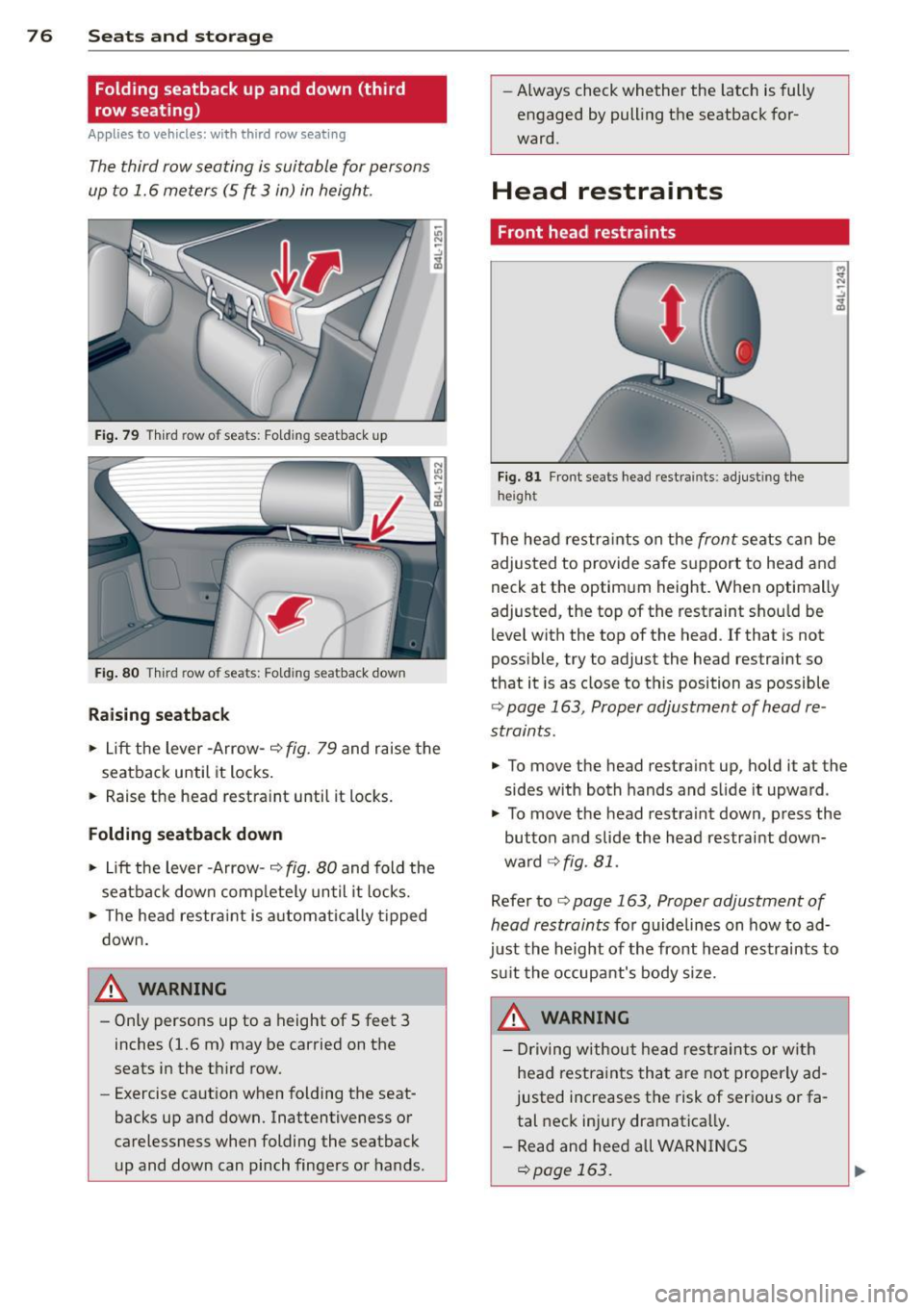
76 Seats and storage
Folding seatback up and down (third
row seating)
Applies to vehicles: with third row seating
The third row s eating i s suitable for p ersons
up to 1.6 meters (5
~ 3 in) in height.
F ig. 79 Thi rd row of seats : F old ing seatba ck up
F ig. 80 T hi rd row of seats: Fold ing seatback dow n
Raising seatback
• Lift the lever -Arrow- ¢ fig. 79 and r aise the
seatback until it loc ks.
• Raise t he head restra int until it locks.
Folding seatback down
• Lift the lever -Arrow- ¢ fig. 80 and fold the
seatba ck down comp lete ly un til it lock s.
• The hea d restra int is a utoma tica lly ti pped
down .
A WARNING
-Only persons up to a height of 5 feet 3
inches (1.6 m) may be carried on the
seats i n the t hird row.
- Exercise caut ion when folding the seat
backs up and down. Inattentiveness o r
carelessness when folding the seatback
up and down can pinch finge rs or hands . -
Always check whether the latc h is fully
engaged by pull ing the seatback for
ward.
Head restraints
Front head restraints
Fi g. 81 Front seats head rest rain ts: a djusting the
h eig ht
T he he ad restr aints on the fr ont sea ts can be
adjus ted to provide safe s upport to he ad and
neck at the optim um height . When optimally
adjusted, the top of the rest raint shou ld be
l evel with the top of the head . If that is not
poss ible, try to adjust the head restraint so
that it is as close to t his position as possible
¢ page 163, Proper adjustment of head re
s traints .
• To move the head restraint up , hold it at the
sides with both hands and s lide it upward .
• To m ove t he head restra int down, press the
button and slide th e head restraint down
wa rd ¢
fig . 81.
Refer to ¢ page 163, Proper adjustment of
head restraints
fo r gu idelines on how to ad
just th e height of the front head r estraints to
s ui t the occupa nt's b ody siz e.
A WARNING
- D riving w ithou t head re str ain ts or wit h
hea d restr aints th at are not pro perly ad
justed increases t he risk of ser ious or fa
tal neck inju ry dramatica lly.
- Read and hee d all W ARNINGS
¢pa ge 163.
-
Page 79 of 342
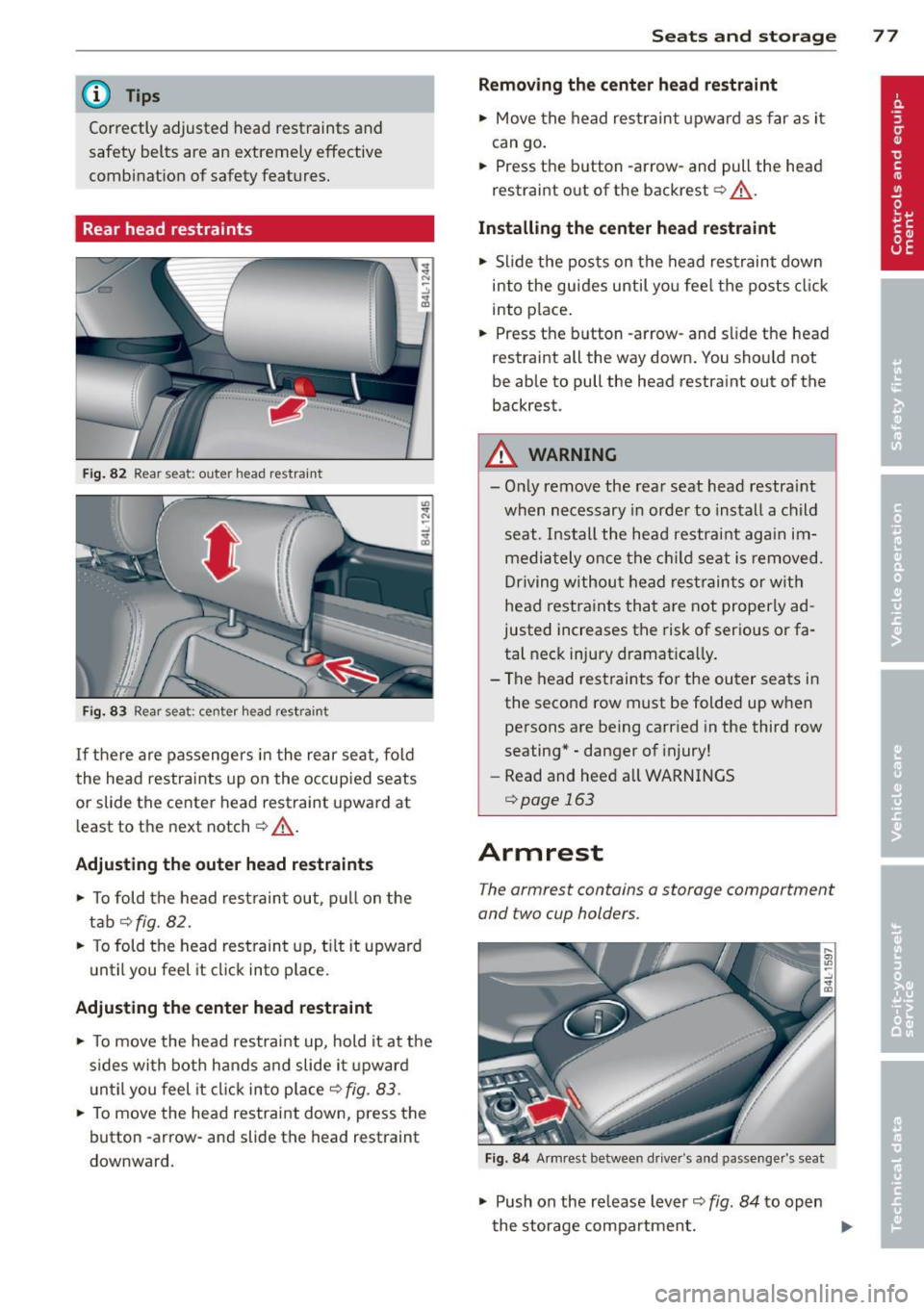
@ Tips
Correctly adjusted head restraints and
safety belts are an extremely effective
com bi nation of safety features.
Rear head restraints
F ig . 82 Rear seat: outer head restraint
Fig. 83 Rear seat; ce nte r head restraint
If there are passengers in the rear seat, fold
the head restraints up on the occupied seats
or slide the ce nter head restraint upward at
least to the next notch ¢ &, .
Adjusting the outer head restraints
• To fold the head restraint out, pull on the
tab
¢fig. 82.
• To fold the head restraint up, til t it upward
until you feel it click into place.
Adjusting the center head restraint
• To move the head restrai nt up, hold it at the
s ides with both hands and slide it upward
u ntil you feel it click into p lace
~ fig. 83.
• To move the head restraint down, press the
button -arrow- and slide the head restraint
downward.
Seats and storage 77
Removing the center head restraint
• Move the head restraint upward as far as it
can go.
• Press the b utton -arrow- and pull the head
restraint out of the backrest¢&,.
Installing the center head restraint
• Slide the posts on the head restraint down
into the guides until you fee l the posts click
into place.
• Press the button -arrow- and sl ide the head
restraint all the way down . You should not
be able to pull the head restraint out of the
backrest.
A WARNING
- Only remove the rear seat head restraint when necessary in order to install a child
seat. Install the head restraint again im mediately once the child seat is removed .
Driving without head restraints or with
head restraints that are not properly ad
justed increases the risk of serious or fa
tal neck injury dramatica lly .
- The head restraints for the outer seats in
the second row must be folded up when
persons are being carried in the third row
seating* -danger of injury!
- Read and heed all WARNINGS
¢page 163
Armrest
The armrest contains a storage compartment
and two cup holders.
Fig. 84 Armrest betwee n dri ver's and passe nger's seat
• Push on the release lever ¢ fig. 84 to open
the storage compartment.
Page 81 of 342
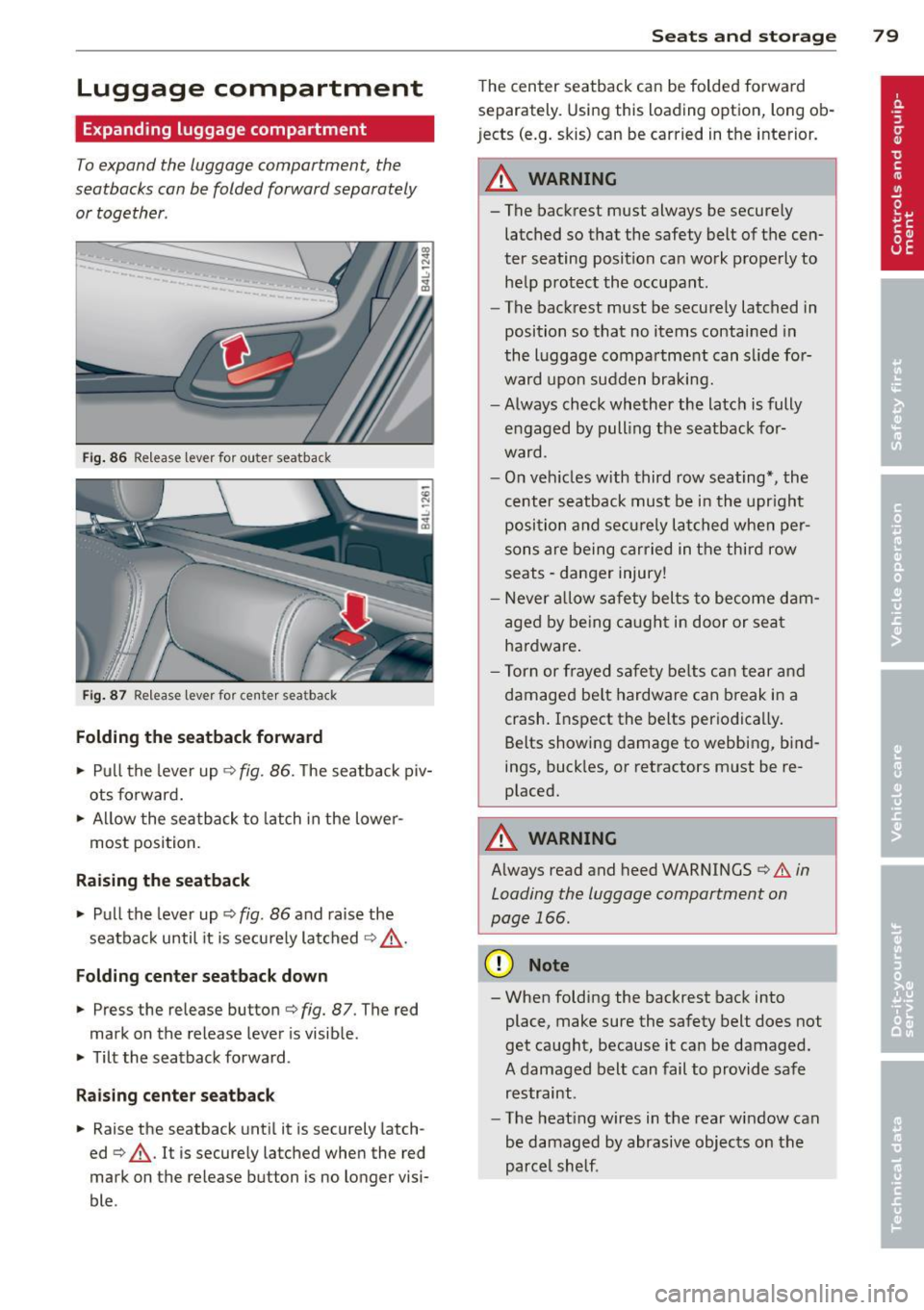
Luggage compartment
Expanding luggage compartment
To expand the luggage compartment, the
seatbacks can be folded forward separately or together .
Fig. 86 Release lever for ou ter seatback
Fig. 87 Release leve r fo r cente r seatback
Folding the seatback forward
.. Pu ll the lever up ¢ fig. 86. The seatback piv
ots fo rward .
.. Allow the sea tba ck to latch in the lowe r
most posi tion.
Raising the seatback
.. Pull the lever up ¢ fig. 86 and ra ise the
seatba ck until it is secu rely latched ¢ _&. .
Folding center seatback down
.. Press the release button ¢ fig. 87. The red
mark on the release lever is visib le .
.. Tilt the seatback forward .
Raising c enter seatback
.. Raise the seatback unt il it is securely latch
ed ¢_&. . It is securely latched when the red
mark on the release button is no longer visi
ble .
Seats and storage 79
The cen ter seatback can be folded forwa rd
separately. Using this loading option, long ob
jects (e.g. skis) can be carried in t he interior.
_& WARNING
-
- The backrest must always be secure ly
latched so that the safety belt of t he cen
ter seating position ca n wo rk p roperly to
he lp p rot ect the occupant.
- The back rest must be securely latched in
position so that no items contai ned in
the l uggage compa rtment can s lide fo r
ward upon sudden braking.
- Always check whether the latc h is fully
e ngaged by pull ing t he seatback for
ward .
- On veh icles with third row seating*, the
cent er seatback must be i n the upr ight
posi tion and se curely la tched whe n pe r
sons are being carried in t he thir d ro w
seats -danger injury!
- Never a llow safety belts to become dam
age d by be ing c augh t in door or sea t
ha rdware .
- Tor n or frayed s afety be lts c an t ear and
damage d be lt hardware can break in a
crash. I nsp ect the belts per io d ica lly.
Belts showi ng damage to webbing, b ind
ings, buck les, or retractors m ust be re
placed.
_& WARNING
A lways read and heed WARNINGS ¢.&. in
Loading the luggage compartment on
page 166 .
(D Note
-When fold ing the backrest back into
place, make sure the safety belt does not
get ca ught, because it can be damaged .
A damaged belt can fail to provide sa fe
restraint .
- The heat ing wires in the rea r window can
be damaged by abrasive objects on the
parce l shelf .
Page 82 of 342

80 Seats and storage
Tie-down rings
There are four tie-down rings in the luggage
compartment for securing luggage items .
liiiil
Fig. 88 Location of the tie-down rings in th e luggage
compartment
., Secure the cargo to the tie-down rings
¢fig. 88 .
., Observe the safety notes ¢ page 167 .
In a collis ion, the laws of physics mean that
even smaller items that are loose in the vehi
cle will turn into heavy missiles that can cause
serious injury. Items in the vehicle pick up ki
netic energy which varies with the vehicle and
the we ight of the item. Vehicle speed is the
most significant factor.
For example, in a frontal collis ion at a speed
of 30 mph (48 km/h), the forces acting on a 10- lb (4. 5 kg) object are about
20 times the
normal weight of the item. T his means that
the weight of the item would suddenly be the
equivalent of about 200 lbs (90 kg). One can
easily imagine the injuries that an item of that
weight flying freely through the passenger
compartment can cause in a collision at a
speed considered relatively low.
A WARNING
Weak, damaged or improper straps used
to secure items to tie-downs can fail dur
ing hard braking or in a collision and cause
serious personal injury.
- Always use suitable retaining straps and
properly secure items to the tie-downs in
the luggage compartment to help pre
vent items from shifting or flying for
ward.
.
- When the rear seat backrest is folded
down, always use suitable retaining
straps and properly secure items to the
tie-downs in the luggage compartment
to help prevent items from flying for
ward into the passenger compartment.
- Never attach a child safety seat tether strap to a tie-down.
Cargo net
Applies to vehicles: wit h cargo net
The cargo net prevents light objects from
sliding around in the luggage compartment.
Fig. 89 Luggage compartment: cargo net
., Next, hang the front hooks in the fastening
eyelets.
., Then, hang the
rear hooks in the fastening
eyelets .
A WARNING
--
For strength-related reasons, the mount·
ing hooks can only be used to secure ob
jects weighing up to 10 lb. (5 kg). Heavier
objects will not be adequately secured -
there is a risk of injury.
Page 84 of 342

82 Seats and st o rage
- So that stale a ir can escape from the ve
hicle be sure not to cover the ventilation
s lot between the rear lid and the lug
gage compartment cover.
Protective liner
Dirty or wet objects con be tronsported under
the cargo floor in a protective tray.
Fig. 92 Cargo floor: folded upright
Fig. 93 Remov ing t he cargo floor
Setting up the ca rg o flo or
• Open the rear lid.
• Set up cargo floor with the help of the han
dle @¢
fig. 92 and adjust the outs ide
edges in the recesses @.
• Lay the items in the protect ive tray.
Folding the cargo floor up
• Open the rear lid.
• Fold the cargo floor up to the seatback with
the help of the handle @.
Rem oving the c arg o floor , in sta ll ing
• Open the rear lid.
• Fo ld the cargo floor up to the seatback with
the help of the handle @.
• To remove, pull the enti re cargo floor out of
the gu ides -arrow-
Q fig . 93 in the direction
of the rear of the vehicle. •
To insta ll the ca rgo floor, set the front of it
into the guides and pus h it in the direction
of the seatback until it engages.
You can also store sma ll items
und er the car
go floor.
T he sto rage room in the pro te ct ive tray can be
enlarged by folding the cargo floor forward or
removing it .
T he protect ive tray can be removed upward by
the grip.
On vehicles with
6 or 7 sea ts* the cargo floor
cannot be folded up, only raised. If the ca rgo
floor is removed, the hooks must be pushed
into the guides under the third row seating
whe n the cargo floor is re-installed.
& WARNING
When the cargo floor is folded upright, the
items being transported must not exceed
the maximum cargo height, 2/3 of the car
go floor space with the floor folded for
ward, or a weight of about 33 lb. (15 kg).
@ Tips
We recommend that you use a tie-down
strap to secure objects to the tie-down
eyelets on the right and left sides of the
vehicle.
· Ski sack
Applies to vehicles: with ski sack
The ski sack allows a maximum of 4 pairs of
skis or 2 snowboards to be carried inside the
vehicle.
F ig. 9 4 Securing the ski sack at the center rear seat
be lt buckle
Page 85 of 342
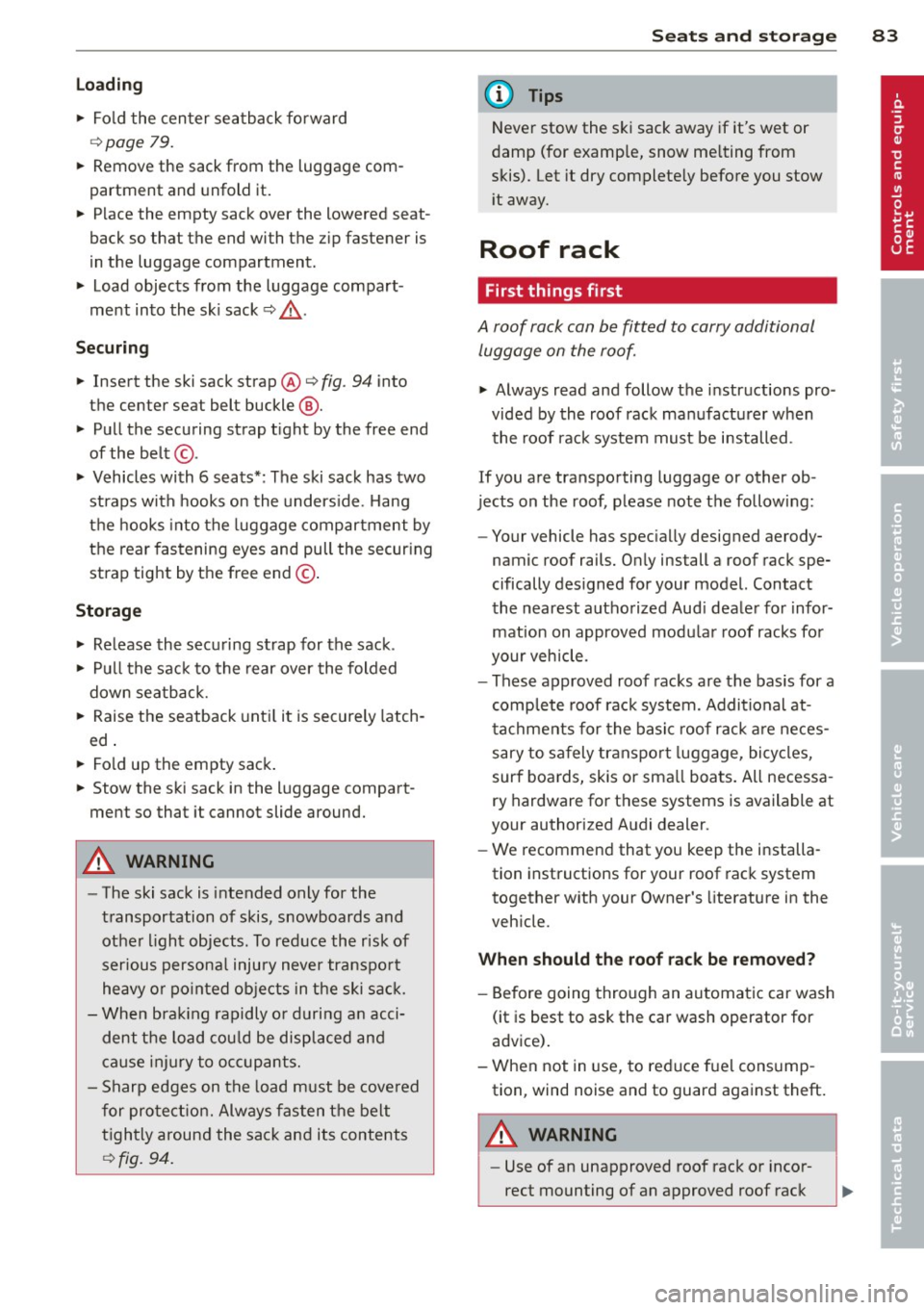
Lo adin g
"' Fo ld the center seatback forward
r=> page 79.
"' Remove the sack from the luggage com
partment and unfold it.
"' Place the empty sack over the lowered seat
back so that the end wi th the z ip fastener is
i n the luggage compartment.
"' Load objects from the luggage compart
ment into the sk i sack
r=> &, .
Securin g
"' Insert the ski sack strap @ r=> fig. 94 into
the center seat belt buckle @.
"' Pull the securing strap t ight by the free end
of the belt @.
"' Vehicles with 6 seats* : The ski sack has two
straps with hooks on the unders ide . Hang
the hooks into the luggage compartment by
the rear fastening eyes and pull the secur ing
strap tight by the free end @.
Storage
"' Re lease the securing strap for the sack .
"' Pull the sack to the rear over the folded
down seatback.
"' Raise the seatback unti l it is securely latch
ed .
"' Fo ld up the empty sack.
"' Stow the ski sack in the luggage compart
ment so that it cannot slide around.
_&. WARNING
-
- The ski sack is intended only for the
transportation of skis, snowboards and
other light objects. To reduce the risk of
serious persona l injury never transport
heavy or po inted ob jects in the ski sack .
- When bra king rapidly o r during an acci
dent the load cou ld be displaced and
ca use inj ury to occupants.
- Sharp edges on the load must be cove red
for protect ion. Always fas ten the belt
t igh tly around the sack and its contents
r=> fig. 94. S
eat s an d sto rage 8 3
(D Tips
Never stow the ski sack away if it's wet or
damp (for examp le, snow me lting from
skis). Let it dry complete ly before you stow
i t away.
Roof rack
First things first
A roof rack can be fitted to carry additional
luggage on the roof.
"' Always read and follow the instructions pro
vided by the roof rack manufacturer when the roof rack system must be installed .
If you are transporting luggage or other ob
jects on the roof, p lease note the following:
- Your vehicle has spec ially designed aerody-
namic roof rails. Only install a roof rack spe
cifically designed for your model. Contact
the nearest authorized Aud i dealer fo r infor
mation on approved modu lar roof racks for
your vehicle.
- These approved roof racks are the bas is for a
complete roof rack system. Additional at
t achments for the basic roof rack a re neces
sary to safely transpo rt luggage, bicycles,
surf boards, skis or sma ll boats. All necessa
ry hardware for these systems is available at
your authorized Audi dealer.
- We recommend that you keep the installa
tion instructions for your roof rack system
together with your Owner's literature in the
veh icle.
When sh ould the roof rac k be remov ed?
- Before going through an automatic car wash
(it is best to ask the car wash operator for
advice) .
- When not in use, to reduce fuel cons ump
tion, wind noise and to guard against theft.
_&. WARNING
- Use of an unapproved roof rack or incor
rect mounting of an approved roof rack
Page 87 of 342
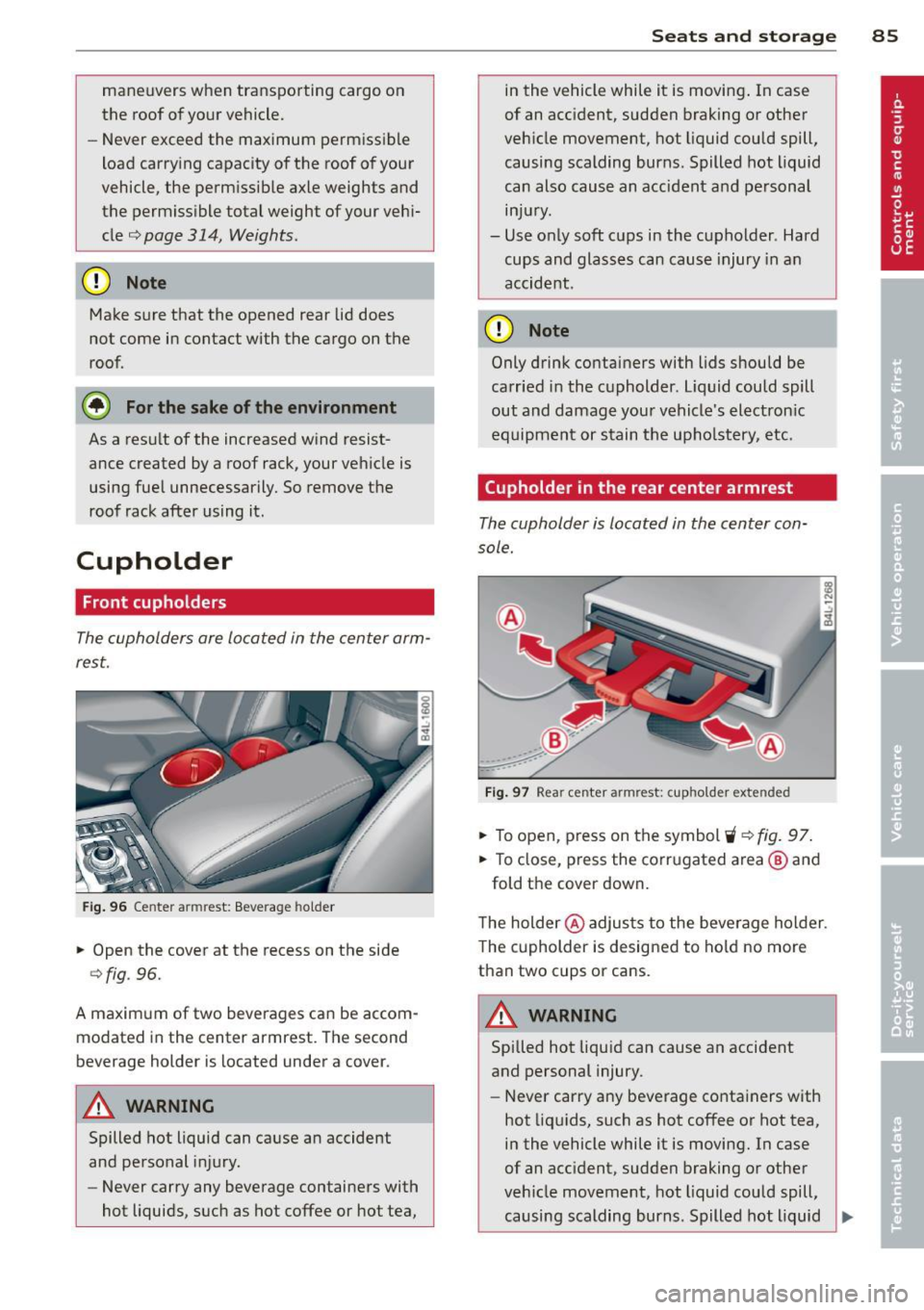
maneuvers when transporting cargo on
the roof of your vehicle.
- Never exceed the maximum permissible
load carrying capacity of the roof of your
vehicle, the permissible axle weights and
the permissible total weight of your vehi cle¢
page 314, Weights.
CD Note
Make sure that the opened rear lid does
not come in contact with the cargo on the
roof.
@ For the sake of the environment
As a resu lt of the increased wind resist
ance created by a roof rack, your vehicle is
using fuel unnecessarily. So remove the
roof rack after using it.
Cupholder
Front cupholders
The cupholders are located in the center arm
rest.
Fig. 96 Center armrest: Beverage holder
.. Open the cover at the recess on the side
¢fig. 96.
A maximum of two beverages can be accom
modated in the center armrest. The second
beverage holder is located under a cover.
A WARNING
Spilled hot liquid can cause an accident
and personal injury.
- Never carry any beverage containers with
hot liquids, such as hot coffee or hot tea,
Seats and storage 85
in the vehicle while it is moving . In case
of an acc ident, sudden braking or other
vehicle movement, hot liquid could spill,
causing scalding burns. Spilled hot liquid
can also cause an accident and personal injury.
- Use only soft cups in the cupholder. Hard cups and glasses can cause injury in an
accident.
CD Note
Only drink containers with lids should be
carried in the cupholder. liquid could spill
out and damage your vehicle's electron ic
equipment or stain the upholstery, etc.
(upholder in the rear center armrest
The cupholder is located in the center con
sole.
Fig. 97 Rear center armrest: cupholder extended
.. To open, press on the symbol 'i ¢fig. 97 .
.. To close, press the corrugated area @ and
fold the cover down.
The holder @adjusts to the beverage holder.
T he cupholder is designed to hold no more
than two cups or cans.
A WARNING
Spilled hot liqu id can cause an accident
and personal injury.
-
-Never carry any beverage containers with
hot liquids, such as hot coffee or hot tea,
in the vehicle while it is moving. In case
of an acc ident, sudden braking or other
veh icle movement, hot liquid could spill,
causing scalding burns. Spilled hot liquid ..,.
Page 164 of 342
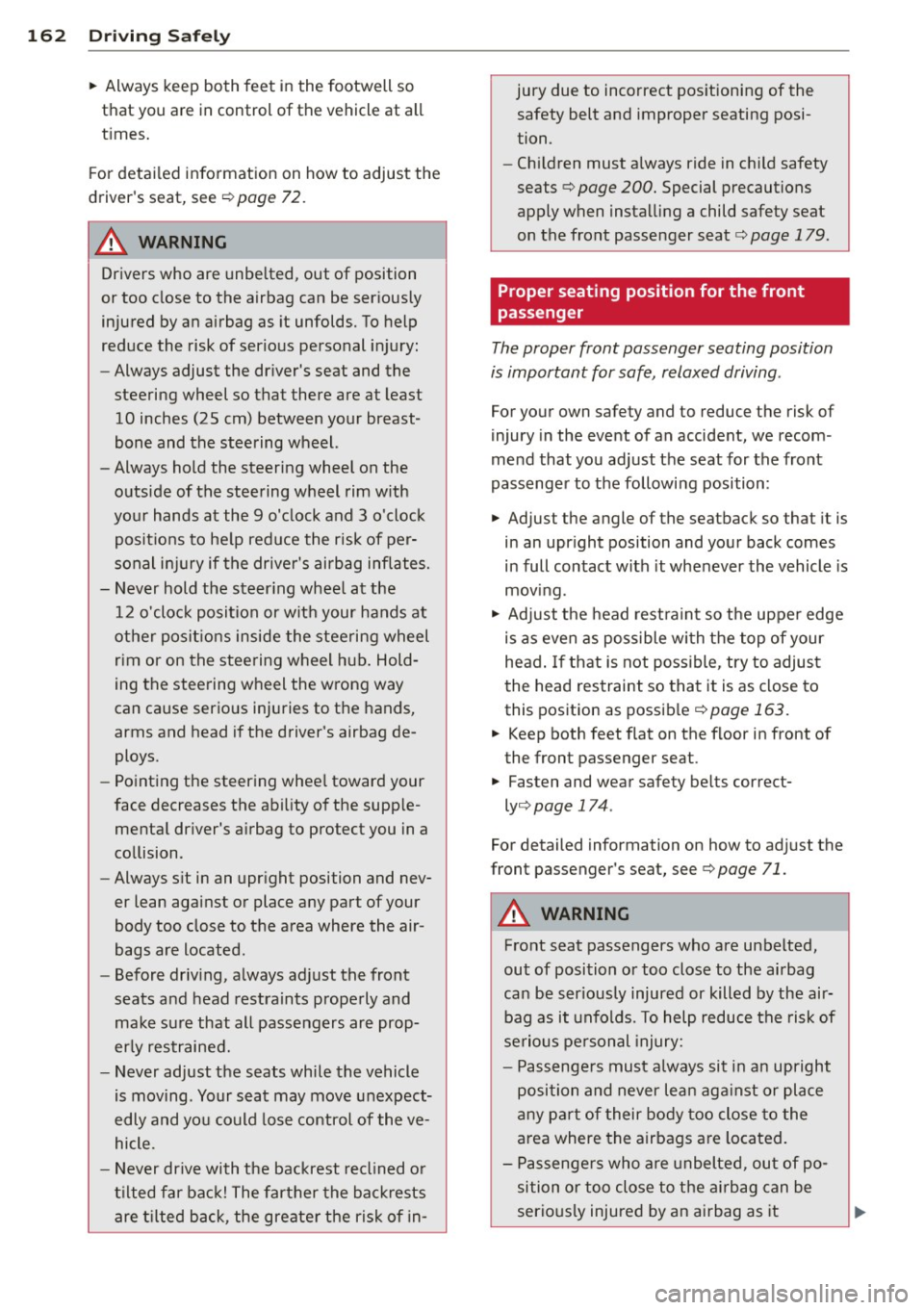
162 Driving Safely
• Always keep both feet in the footwell so
that you are in control of the vehicle at all
times.
For detailed information on how to adjust the
driver's seat, see
¢ page 72.
A WARNING
Drivers who are unbelted, out of position
or too close to the airbag can be seriously
injured by an airbag as it unfolds. To help
reduce the risk of serious personal injury:
- Always adjust the driver's seat and the
steering wheel so that there are at least
10 inches (25 cm) between your breast
bone and the steering wheel.
- Always hold the steering wheel on the
outside of the steering wheel rim with
your hands at the 9 o'clock and 3 o'clock positions to help reduce the risk of per
sonal injury if the driver's airbag inflates.
- Never hold the steering wheel at the
12 o'clock position or with your hands at
other positions inside the steering wheel
rim or on the steering wheel hub. Hold
ing the steering wheel the wrong way
can cause serious injuries to the hands,
arms and head if the driver's airbag de
ploys.
- Pointing the steering wheel toward your
face decreases the ability of the supple
mental driver 's airbag to protect you in a
collision .
- Always sit in an upright position and nev
er lean against or place any part of your
body too close to the area where the air
bags are located.
- Before driving, always adjust the front
seats and head restraints properly and
make sure that all passengers are prop
erly restrained.
- Never adjust the seats while the vehicle
is moving . Your seat may move unexpect
edly and you could lose control of the ve
hicle.
- Never drive with the backrest reclined or
tilted far back! The farther the backrests
are tilted back, the greater the risk of in- jury due to incorrect positioning of the
safety belt and improper seating posi
tion.
- Children must always ride in child safety
seats ¢
page 200. Special precautions
apply when installing a child safety seat
on the front passenger seat¢
page 179 .
Proper seating position for the front
passenger
The proper front passenger seating position
is important for safe, relaxed driving .
For your own safety and to reduce the risk of
injury in the event of an accident, we recom
mend that you adjust the seat for the front
passenger to the following position :
• Adjust the angle of the seatback so that it is
in an upright position and your back comes
in full contact with it whenever the vehicle is
moving .
• Adjust the head restraint so the upper edge
is as even as possible with the top of your
head. If that is not possible, try to adjust
the head restraint so that it is as close to
this position as possible ¢
page 163.
• Keep both feet flat on the floor in front of
the front passenger seat .
• Fasten and wear safety belts correct
ly ¢
page 174 .
For detailed information on how to adjust the
front passenger's seat, see ¢
page 71.
A WARNING
-Front seat passengers who are unbelted,
out of position or too close to the airbag
can be seriously injured or killed by the air
bag as it unfolds. To help reduce the risk of
serious personal injury:
- Passengers must always sit in an upright
position and never lean against or place
any part of their body too close to the
area where the airbags are located.
- Passengers who are unbelted, out of po
sition or too close to the airbag can be
seriously injured by an airbag as it
Page 165 of 342

unfolds with great force in the blink of
an eye .
- Always make sure that there are at least
10 inches (25 cm) between the front
passenger 's breastbone and the instru
ment panel.
- Each passenger must always sit on a seat of the ir own and properly fasten and
wear the safety belt be longing to that
seat .
- Before driving, always adjust the front
passenger seat and head restra int prop
erly .
- Always keep your feet on the f loor in
front of the seat. Never rest them on the
seat, instrument panel, out of the win dow, etc. The airbag system and safety
belt w il l not be ab le to protec t you prop
er ly and can even increase the risk of in
jury in a crash .
- Never drive with the backrest reclined o r
ti lted far back! The farther the backrests
are ti lted back , the greater the risk of in
jury due to incorrect positioning of the
safety belt and improper seating posi
t ion.
- Children must always ride in child safety
seats
c> page 200 . Special precautions
apply when installing a child safety seat
on the front passenger seat
c> page 179 .
Proper seating positions for passengers
in rear seats
Rear seat passengers must sit upright with
both feet on the floor consistent with their
physical size and be properly restrained whenever the vehicle is in use .
To reduce the risk of injury caused by an incor
rect seat ing pos ition in the event of a sudden
brak ing maneuve r or an acc ident , your pas
se ngers on the rea r bench seat must always
observe the fo llow ing :
~ If there are passengers in the rear seat, fold
the head rest ra ints up on the occupied seats
or slide the center head restrain t upward at
least to the next notch
c> page 77 .
Dr ivin g Sa fely 163
~ Make s ure that the seatback is secure ly
latch ed in the upright posi tion
c> page 79.
~ Keep both feet flat in the footwell in front
of the rear seat.
~ F asten and wear safety be lt s properly
<=> page 174 .
~ Make sure that children are always properly
restrained in a child restraint that is appro
pria te fo r the ir s ize and age ¢
page 200.
A WARNING
Passengers who are imp roperly seated on
the rear seat can be se riously inj ured in a
crash .
- Each passenger must always si t on a seat
of their own and properly fasten and
wear the safety belt belonging to that
seat .
- Safety belts only offer maximum protec
tion when the seatback is sec urely latch
ed in the upright position and the safety
be lt s are properly posit ioned on the
body . By not s itting up right, a rear seat
passenger increases the risk of personal
in jury from improperly positioned safety
be lts!
- Always adjust the head restraint p roperly
so that it can give maximum protection .
Proper adjustment of head restraints
Correctly adjusted head restraints are an im
portant port of your vehicle's occupant re
straint system and can help to reduce the risk
of injuries in accident situations .
Fig. 1 83 Head restr ain t: v ie wed from th e front
The head restraints must be correct ly adjust-
ed to achieve the best protectio n. ..,.